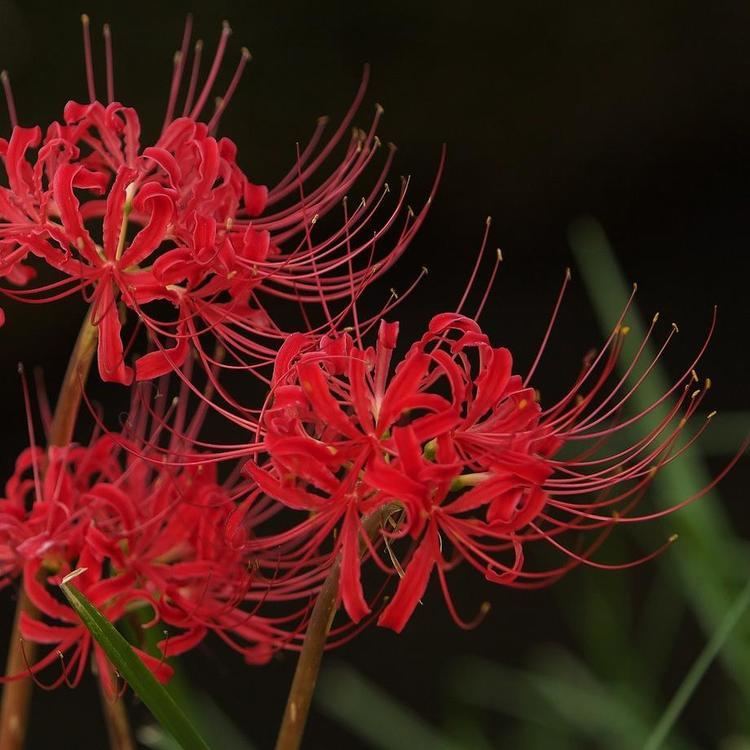Clade Monocots Rank Species | Clade Angiosperms | |
 | ||
Similar Lycoris, Amaryllidaceae, Amaryllis, Lycoris squamigera, Jimsonweed | ||
How to plant red spider lilies lycoris radiata with bulb planter
Lycoris radiata, known as red spider lily, red magic lily, or in Chinese mànzhū shā huá (曼珠沙華), is a plant in the amaryllis family, Amaryllidaceae, subfamily Amaryllidoideae. Originally from China, Korea and Nepal, it was introduced into Japan and from there to the United States and elsewhere. It is considered naturalized in Seychelles and in the Ryukyu Islands. It flowers in the late summer or autumn, often in response to heavy rainfall. The common name hurricane lily refers to this characteristic, as do other common names, such as resurrection lily; these may be used for the genus as a whole.
Contents
- How to plant red spider lilies lycoris radiata with bulb planter
- Description
- Taxonomy
- Cultivation
- Uses
- Legends
- References

Description

Lycoris radiata is a bulbous perennial. It normally flowers before the leaves fully appear, on stems 30–70 centimetres (12–28 in) tall. The leaves are parallel-sided, 0.5–1 centimetre (0.20–0.39 in) wide with a paler central stripe. The red flowers are arranged in umbels. Individual flowers are irregular, with narrow segments which curve backwards, and long projecting stamens.
Taxonomy

The presumed original form of Lycoris radiata, known as L. radiata var. pumila, occurs only in China. It is a diploid, with 11 pairs of chromosomes (2N = 22), and is able to reproduce by seed. Triploid forms, with 33 chromosomes, are known as L. radiata var. radiata. These are widespread in China and also in Japan, from where the species was introduced into cultivation in America and elsewhere. The triploid forms are sterile, and reproduce only vegetatively, via bulbs. The Japanese triploids are genetically uniform. It has been suggested that they were introduced into Japan from China along with rice cultivation.
In phylogenetic analyses based on chloroplast genes, Hori et al. found that all the other species of Lycoris they examined were nested within Lycoris radiata. They suggest that the "species" of Lycoris presently recognized may not be distinct.
Cultivation
The plant was first introduced into the United States in 1854 when Japanese ports were opened for US trade. Captain William Roberts, who enjoyed botany, brought back only three bulbs of the red spider lily. The bulbs were then planted by his niece who found that they do not bloom until after the first good rain in the fall season. Plants have since become naturalized in North Carolina, Texas, and many other southern states of the US. Since the Japanese forms are sterile triploids, the introduced plants were also sterile and reproduce only by bulb division.
Lycoris radiata is not frost-hardy and so can only be grown under glass or in a very sheltered position in countries like England which are subject to frost. Bulbs can be stored in a dry environment between 45–55 degrees Fahrenheit (7–13 degrees Celsius). They should be planted in the spring in full sun in well-drained soil (e.g. sandy with some clay), 8 inches (20 cm) deep, with 6–12 inches (15–30 cm) between each bulb, and left undisturbed. Plants will flower in late summer or early fall, with stems around 24–28 inches (60–70 cm) tall. Leaves follow the flowers, remaining through the winter and disappearing in early summer.
Uses
The bulbs of Lycoris radiata are very poisonous. These are mostly used in Japan, and they are used to surround their paddies and houses to keep the pest and mice away. That is why most of them grow close to rivers now. In Japan the Red Spider Lily signals the arrival of fall. Many Buddhist will use it to celebrate the arrival of fall with a ceremony at the tomb of one of their ancestors. They plant them on graves because it shows a tribute to the dead. People believe that since the Red Spider Lily is mostly associated with death that one should never give a bouquet of these flowers.
Legends
Since these scarlet flowers usually bloom near cemeteries around the autumnal equinox, they are described in Chinese and Japanese translations of the Lotus Sutra as ominous flowers that grow in Diyu (also known as Hell), or Huángquán (Simplified Chinese: 黄泉; Traditional Chinese: 黃泉), and guide the dead into the next reincarnation.
Some legends have it that when you see someone that you may never meet again, these flowers, also called red spider lilies or corpse flowers, would bloom along the path. Perhaps because of these sorrowful legends, Japanese people often used these flowers in funerals. The popular Japanese name Higanbana (彼岸花, Higan bana) for Lycoris radiata literally means higan (the other or that shore of Sanzu River) flower, decorate and enjoyable, flower of afterlife in gokuraku jyōdo (極楽浄土, gokuraku jyōdo).
